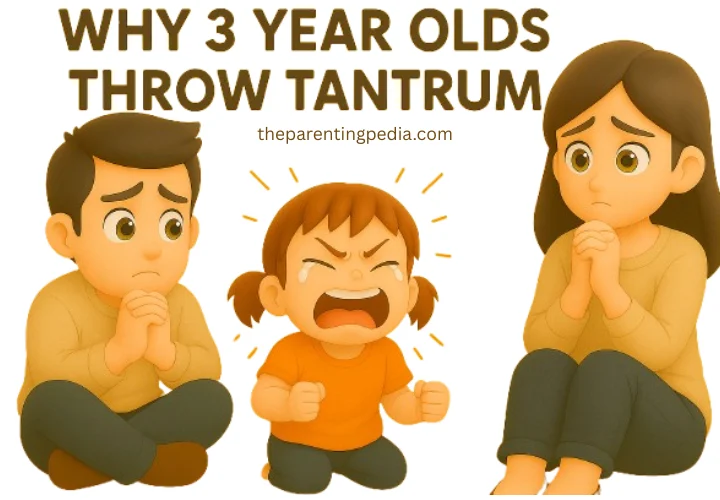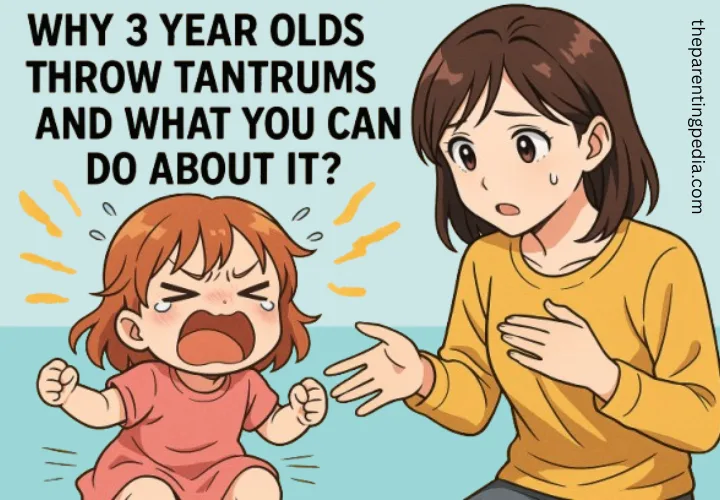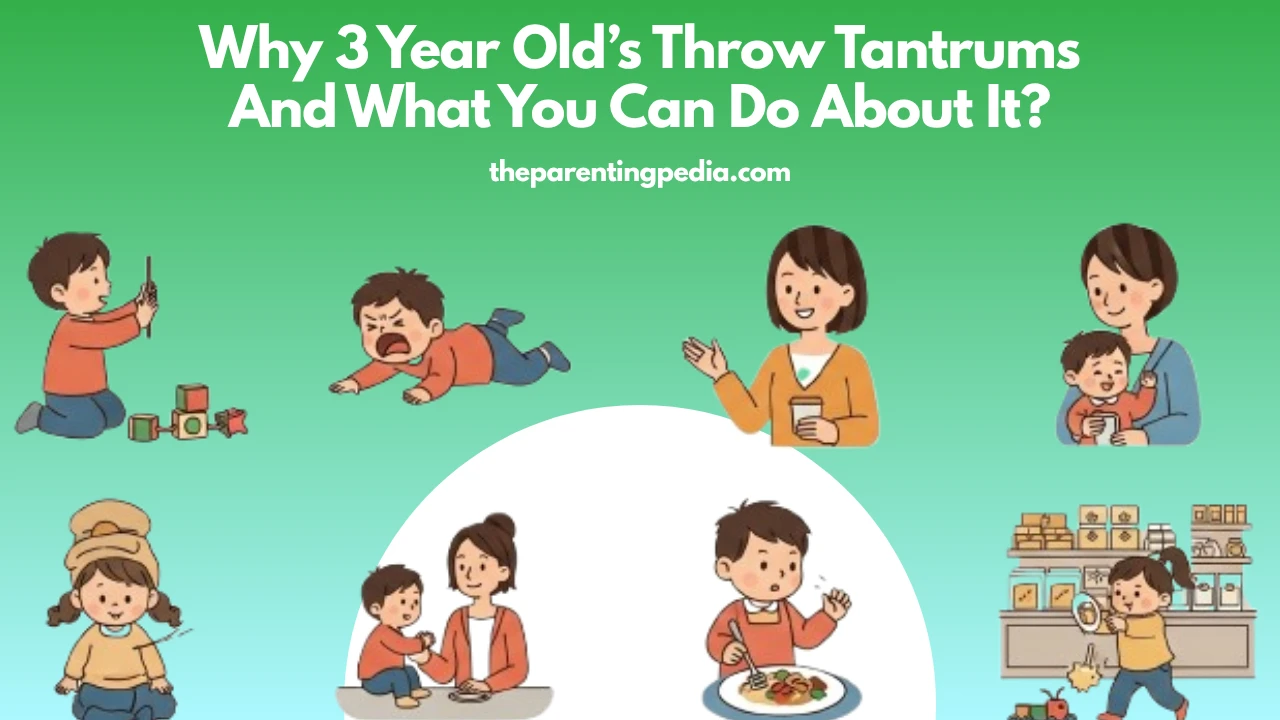Your child is now three years old. They can speak more words, run around and even tell short stories. But despite all the growth, they might still throw themselves on the floor, scream at the top of their lungs or refuse to listen when something doesn’t go their way. Yes, 3 year olds still show tantrums and sometimes, they might even feel bigger than before. If you are wondering why your 3 year old still throws tantrums, you are not alone. Tantrums are very common at this age and part of healthy development. Read on to know more about 3 year olds tantrums and what you can do about it.
What Is a Tantrum?
A tantrum is a sudden outburst of strong emotions. It can involve crying, yelling, kicking, hitting, running away or refusing to move. Some children may throw toys, slam doors or even say things like “I hate you!” during a tantrum. Tantrums are not a sign that your child is bad. They are a way for your child to express feelings they don’t know how to handle yet. At age three, your child is caught between wanting independence and still needing help and that can be a bit overwhelming for them.

Why 3-Year-Olds Still Have Tantrums?
Even though 3 year olds have more words and better understanding, tantrums can still happen frequently. Here is why 3 year olds still have tantrums:
1. Big Emotions Are Hard to Handle: 3 year olds experience strong feelings like anger, fear, jealousy and frustration. They feel them intensely but don’t yet know how to manage them calmly. Tantrums are often a result of emotional overload in toddlers.
2. Better Words, But Not Enough: Yes, your child can now speak in short sentences and understand more instructions, but they still don’t have all the words to explain how they feel. When they can’t find the right words especially when upset, they may cry or scream instead.
3. Testing Limits and Boundaries: At three, kids are very curious. They want to explore everything, do things by themselves and make their own choices. When they are told “no” or something doesn’t go their way, a tantrum can follow. They are testing where the limits are and also learning about rules to follow.
4. Desire for Control: 3 year olds want to feel in charge of their world. Simple things like picking their clothes, choosing what to eat or deciding when to play become very important. If they feel they don’t have control, they may protest loudly.
5. Overstimulation and Tiredness: A long day, loud environment or too many changes in routine can make a child tired or overwhelmed. This often leads to tantrums, especially when nap times are skipped or bedtime is delayed.
Common Tantrum Triggers In 3 Year Olds
Following are situations that can trigger tantrums in 3 year olds:
- Being told “no”
- Having to share toys
- Not getting a snack or treat
- Getting dressed or brushing teeth
- Having to stop a favorite activity
- Tiredness, hunger or boredom
- A change in daily routine
What You Can Do During a 3 Year Old Tantrum?
Handling tantrums with calmness and care helps your child feel secure even when they are losing control. Here is what you can do:
1. Stay Calm Yourself: Your child looks to you for how to respond. If you stay calm, it helps them settle sooner. Take a deep breath, keep your voice soft and firm and remind yourself that your child is not doing this on purpose.
2. Don’t Argue or Overreact: Trying to reason with a screaming child usually does not work. Avoid arguing, yelling or saying things in anger that you might regret. Wait until the storm passes.
3. Acknowledge Their Feelings: Let them know you understand. Say things like “I see you are upset because we are leaving the park.” or “You are mad because your toy broke. That is okay.” This shows your child that feelings are allowed, but not bad behavior.
4. Use Fewer Words: When emotions are high, your child cannot process long explanations. Use short, calm phrases like “You are safe”, “I am here.” or “Let’s take deep breaths.”
5. Offer Comfort or Space: Some children want a hug. Others need a little space to calm down. Watch your child’s hints. Stay nearby and be ready to comfort when they are ready.
What To Do After A 3 Year Old Tantrum?
Once child is calm, parents can use this time to reconnect and teach children by following given steps:
1. Cuddle And Reassure: Parents should let their child know that they still love them. A hug or soft words can make them feel safe again.
Also Read: Helping Kids Understand Money: A Guide to Financial Literacy
2. Talk About What Happened: Use simple words to explain 3 year old children about their wrong behavior. For example, say things like “You were upset when I said no to more cookies. It is okay to feel sad, but we don’t scream.” or “Next time you can say, ‘I am mad’ and we will talk.” This helps build emotional understanding over time.
3. Praise Good Behavior: Catch your child when they do something good. Say things like “Thank you for waiting your turn.” or “I like how you used your words.” Positive attention teaches children what to do next time.
How To Reduce 3 Year Old Tantrums Over Time?
You cannot stop tantrums completely as they are part of growing up. But there are ways to reduce how often and how intensely they happen.
1. Stick to a Routine: Children feel more secure when they know what is coming next. Keep meal times, nap times and bedtimes regular. Predictability helps reduce frustration in 3 year old children.
2. Offer Simple Choices: Give your child a sense of control by offering two choices like “Do you want the blue cup or the red cup?” or “Should we brush teeth before or after story time?” Avoid open ended choices that might overwhelm children.
3. Give Warnings For Transitions: Let your child know when a change is coming. For example, tell them, “Five more minutes, then we are leaving.” or “One more story, then it is bedtime.” This helps prepare their mind for change.
4. Use Clear, Gentle Limits: Set rules and stick to them. Be kind but firm towards children. Say things like “I know you want more TV, but it is time to stop.” or “We can be angry, but we should not hit.” Consistency helps child feel safe and understand expectations.
5. Watch for Hunger and Tiredness: Always carry snacks and water when going out. Don’t skip naps or delay bedtime too long. A tired or hungry child is more likely to cause tantrums.

Conclusion
Tantrums at age three are normal. Parents should understand that their child is learning how to manage big feelings, understand rules and express themselves. While this stage can feel tough, it is also full of growth, discovery and bonding opportunities. When parents respond to tantrums with calm, love, and steady guidance, they are teaching their three year old child emotional strength and helping them grow into a confident person. It won’t be perfect every day and that is okay. What matters most is parents connection with their child and efforts they put to understand them.
FAQ
How do I fix my 3 year olds tantrums?
Stay calm, set clear boundaries and maintain a consistent routine. Acknowledge their feelings without giving in. Use distraction, offer choices and praise good behavior. Avoid yelling or bribing. After the tantrum, reconnect with love. Tantrums are normal, patience and empathy help 3 year old learn self-control over time.
Should I ignore my 3 year old tantrums?
Ignore tantrums only if they are for attention and your child is safe. Stay calm, nearby, and emotionally available. Don’t engage or give in, but comfort afterward. For tantrums from frustration or needs, acknowledge feelings and guide them calmly. Consistency and empathy help your child learn emotional regulation over time.
